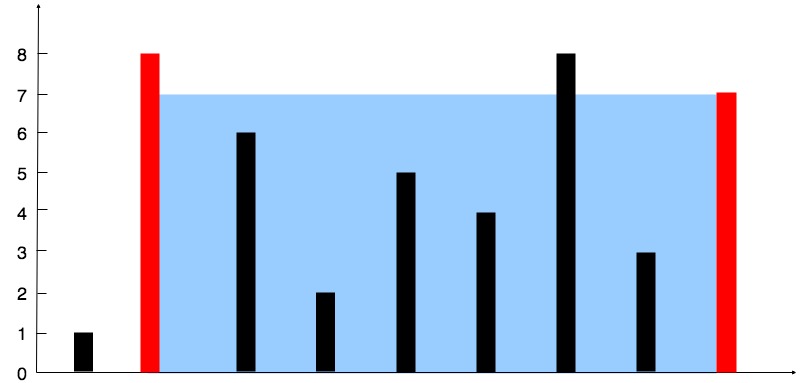Given n non-negative integers a1, a2, ..., an , where each represents a point at coordinate (i, ai). n vertical lines are drawn such that the two endpoints of the line i is at (i, ai) and (i, 0). Find two lines, which, together with the x-axis forms a container, such that the container contains the most water.
Notice that you may not slant the container.
Example 1:

Input: height = [1,8,6,2,5,4,8,3,7] Output: 49 Explanation: The above vertical lines are represented by array [1,8,6,2,5,4,8,3,7]. In this case, the max area of water (blue section) the container can contain is 49.
Example 2:
Input: height = [1,1] Output: 1
Example 3:
Input: height = [4,3,2,1,4] Output: 16
Example 4:
Input: height = [1,2,1] Output: 2
Constraints:
n == height.length2 <= n <= 1050 <= height[i] <= 104
My Code:
class Solution {
public int maxArea(int[] height) {
int maxWater = 0;
int left = 0;
int right=height.length -1;
while (left<right){
maxWater = Math.max(maxWater, (right-left)*Math.min(height[left],height[right]));
if (height[left]<height[right]) left ++;
else right --;
}
return maxWater;
}
}
Alternate Code:
class Solution {
public int maxArea(int[] height) {
int [] [] area = new int[height.length][height.length];
int prod = 0;
for (int i = 0; i<height.length;i++){
for(int j=i+1;j< height.length;j++){
int distance = Math.abs(j-i);
if (height[i]<height[j]){
area[i][j-1] = height[i]*distance;
}
else{
area[i][j-1] = height[j]*distance;
}
}
}
for (int i = 0; i<height.length;i++){
for (int j =0; j<height.length;j++){
if (area[i][j]>prod){
prod = area[i][j];
}
}
}
return prod;
}
}
No comments:
Post a Comment